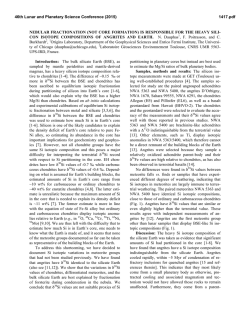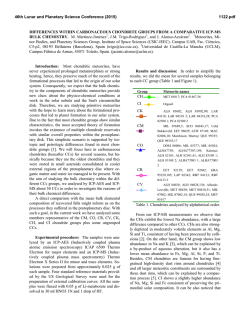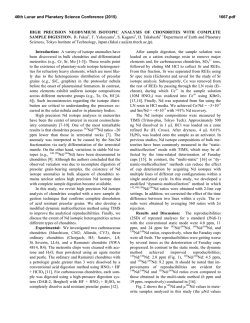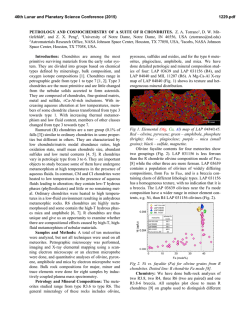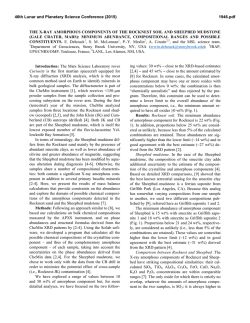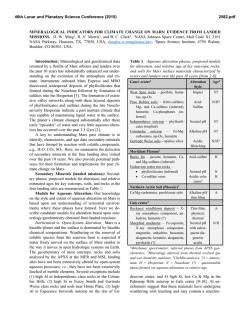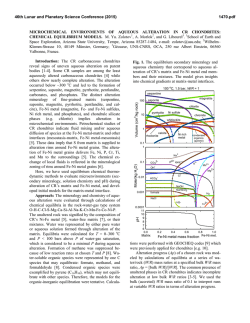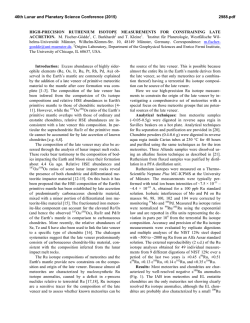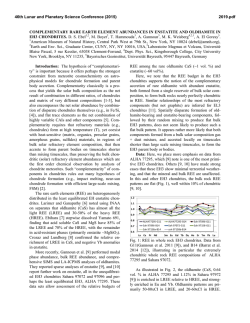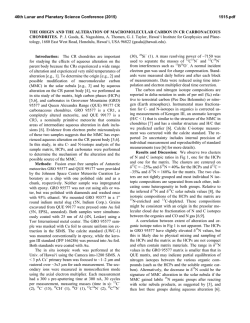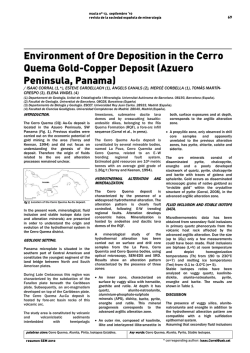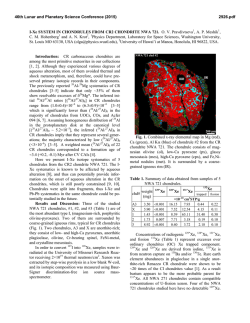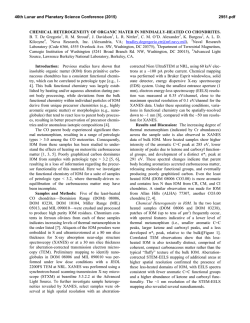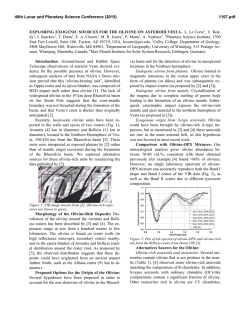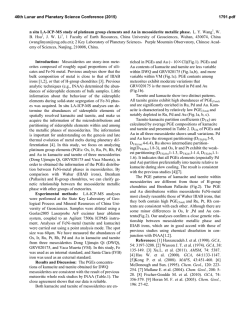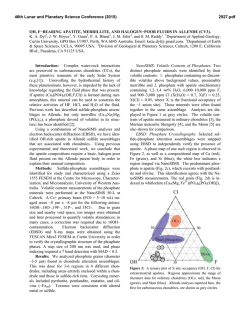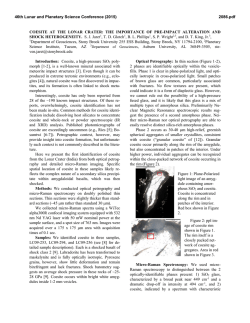
ubiquitous oxidized and hydrated amorphous silicates in
46th Lunar and Planetary Science Conference (2015) 2599.pdf UBIQUITOUS OXIDIZED AND HYDRATED AMORPHOUS SILICATES IN CARBONACEOUS AND ORDINARY CHONDRITES: IMPLICATIONS FOR ALTERATION CONDITIONS AND H2 DEGASSING OF ASTEROIDS. C. Le Guillou1,2; H. G. Changela3 and A. J. Brearley3, 1IMPMC-MNHN, 61 rue Buffon, 75005, Paris, France; 2Ruhr Universität Bochum, 150 Universität Strasse, Bochum, Germany, [email protected] ; University of New Mexico, Albuquerque, NM, USA, [email protected] ; [email protected] Introduction: The CR chondrites carry one of the most pristine records of solar nebula materials that accreted to form planetesimals. They have experienced aqueous alteration ranging from incipient in their matrices to the complete hydration of their components. Investigating alteration reactions is crucial for constraining the nature of the precursor materials and the conditions of aqueous alteration on the chondrite parent bodies. The matrices of the CR chondrites consist mostly of a groundmass of iron-bearing amorphous silicate, mixed to various degrees with nano-scale phyllosilicates. In a few cases, weakly altered CMs (Paris, Yamato 791198), ordinary chondrites (Bishunpur), CO chondrites (Allan Hill 77307) also carry similar amorphous silicates [1]. The ubiquitous presence of this amorphous silicate has led to the suggestion that it could have been the precursor material that accreted to form matrices [1]. This highly reactive, fine-grained material is the first to be hydrated, and is then transformed into short-range order serpentine/saponite [2]. To constrain their chemical alteration pathways and the effect of increasing alteration, we have investigated the mineralogy and Fe-oxidation state of silicates in the matrices of 8 CR chondrites. In a second step, we started analyzing ordinary chondrites (UOCs), CO and CM chondrite as well, in order to compare the alteration conditions and the redox state across chondrite groups. There are limited data on Fe redox states at the scale of individual matrix grains[3]. However, bulk matrix XANES was performed on CR, CM and CI chondrites [4]. These data show that increasing aqueous alteration increases bulk Fe3+/∑Fe ratios. Oxidation of iron occurs during serpentinization processes, and the resulting Fe3+ can be found either in magnetite or serpentine, depending on the conditions [5]. Oxidation is coupled to the reduction of water, which in turn releases H2. Methods: Eight samples covering the alteration range of the CR chondrites were investigated: QUE 99177 (CR3.0), EET 87770 (CR2), EET 92042 (CR2), LAP 02342 (CR2), GRA 95229 (CR2), Renazzo (CR2), Al Rais (CR2) and GRO 95577, (CR1). In addition, UOCs (Semarkona, Bishunpur, QUE 97008), CO (ALH 77307), CMs (Paris, Tagish Lake, TIL 91722) were also investigated. Matrix fragments were pressed into indium foils. Twenty eight FIB sections in total were investigated. Fe-L edge X-ray Absorption Near Edge Structure (XANES) was performed on FIB sections using synchrotron-based scanning transmission X-ray microscopy (STXM). The Fe3+/∑Fe ratios of the submicron silicate particles were determined quantitatively and measurements were then coordinated with TEM observations. Results: Most analyzed silicates (either amorphous or nanocrystalline) in the least altered CR chondrites (QUE 99177, EET 87770 and EET 92042) have an intermediate composition between serpentine and saponite, with Mg# between 40 and 50%. The phyllosilicates in GRO 95577 and Al Rais matrix, by contrast, are consistently lower in iron and higher in Si. In these highly altered chondrites, two silicate populations are present: the coarser grains (500 nm to 1 µm sized) have a higher Si+Al content and plot towards the saponite stoichiometry whereas the fine-grained phyllosilicates (<100 nm) have an intermediate composition between that of the amorphous silicate in type 3 and 2 CRs and the coarse-grained phyllosilicates. Fig. 1: Fe3+/∑Fe ratios of amorphous silicate and phyllosilicates vs. increasing alteration degree. The three most altered samples, e. g. Renazzo, Al Rais and GRO 95577 show 2 groups, with the coarser grain phyllosilicates having lower Fe3+/∑Fe ratios than the very fine-grained silicates (amorphous or nanocrystalline). Across all CR chondrites, the Fe3+/∑Fe ratio varies between 50% and 75%. We observe a decrease in Fe3+/∑Fe ratio of the silicates with increasing alteration degree. The silicates in the less altered samples have a relatively high and homogeneous oxidation state (~ 65 - 75% Fe3+). No difference is observed between the amorphous material and the fine-grained phyllosilicates. In contrast, the two more altered chondrites (GRO 95577 and Al Rais) contain fine- and coarse- 46th Lunar and Planetary Science Conference (2015) grained phyllosilicates with distinct Fe3+/∑Fe ratios. The coarse-grained phyllosilicates have a lower Fe3+/∑Fe ratio than the fine-grained ones, by ~10 to 20 % (Fig. 1, 2). Fig. 2 : TEM and STXM composite image from Al Rais, and corresponding spectra of coarse and fine-grained silicates. In the measured UOCs, CMs and CO chondrites, amorphous silicates are also almost systematically present. They are observed in Semarkona for the first time. Their Fe3+/∑Fe ratio is always above 60%. Bishunpur stands alone, however, with less iron and a lower Fe3+/∑Fe (<50%) in its silicates. Quantitative analysis for those meteorites are in progress. Discussion: The presence of amorphous Fe-rich silicates in all weakly altered CRs, CO, CMs and low petrologic type UOCs chondrites support the claim that amorphous silicates were the precursor of matrices [1]. They could either be genetically linked to GEMS or, alternatively, they could have formed concomitantly with chondrules. In both cases, they would have most likely contained pure Fe2+ at the time of accretion if they were condensates from the nebula. Anhydrous, amorphous silicates were altered in 2 steps: i) hydration/oxidation to form a hydrated amorphous gel-like phase and ii) further growth of the phyllosilicates [6]. The iron valency data now allow balanced reactions to be described and to establish the mass budget for iron and water. All silicates are highly oxidized, even in the least altered chondrites. This shows that the first stage of alteration is the widespread oxidation of Fe2+ to Fe3+. It also indicates that the iron from the silicate precursor while being oxidized, remained in the secondary sili- 2599.pdf cates (not available for magnetite formation). It is now known that the least altered CR chondrite matrices are extensively hydrated [7, 8] and that the amorphous silicate do carry water as well [2]. Based on these constraints (composition, Fe3+/∑Fe, H2O wt.%), a possible reaction can be written which applies to the least altered CR chondrites and possibly also to the least altered CMs, COs and UOCs: + 0.9H2O (Mg0.4,Fe0.6)SiO3 (amorphous) (Mg0.4,Fe2+0.2,Fe3+0.4)SiO2.5(OH)1.4(amorphous) + 0.2 H2 Nucleation and growth of crystalline phyllosilicates seems to have been kinetically-limited in most petrologic type 3 and 2 CRs, but increased as alteration became extensive in Al Rais and GRO 95577. In these more altered CRs, the Fe3+/∑Fe ratio varies from 70% to 50% for coarse and fine grained phyllosilicate. It appears that, while aqueous alteration progressed (higher temperature, longer duration, change of fluid composition), Fe3+ was redistributed from silicates to iron oxides (possibly leading to the framboidal magnetite) while phyllosilicates were forming. The reaction pathway below summarizes the advanced stage of alteration observed in GRO 95577 and Al Rais, e.g. the further alteration of hydrated/oxidized amorphous silicate. The mass balance is an approximation, but it is the best that can be made at this point: 5(Mg0.4, Fe2+0.2, Fe3+0.4)SiO2.5(OH)1.4+ 1.21Mg2++ SiO2+ 2.72H2O (Mg1.2, Fe2+0.45, Fe3+0.9)Si2O5(OH)4+ (Mg0.67, Fe2+0.12, Fe3+0.14,)3Si4O10(OH)2(H2O)2 + Fe3O4 + 0.28Fe2O3+ 2.44 H2 Implications: In a fully closed system, equilibrium thermodynamics suggest that the water to rock ratios, typically assumed to be low (<1) for chondrites, should primarily control the iron valency of the silicates and predict a lower Fe3+/∑Fe ratio [5]. Such a high Fe3+/∑Fe value could be accounted for, however, if the system was partially open, at least with respect to H2 (and other gases as well). Indeed, a rapid H2 degassing from the fluid, faster than the reactions themselves would have favored more oxidizing fluid conditions. Recently proposed scenarios [9] involving some degree of water D/H increase through Rayleigh isotopic fractionation are supported by these results and may have occurred in all chondrite parent bodies. References: [1] Brearley A. J. (1993) GCA, 57, 1521-1550. [2] Le Guillou C. and Brearley A. J. (2014) GCA, 131, 344–367. [3] Zega T. et al. (2003) Am. Min 88, 1169–1172 [4] Beck P. et al. (2012) GCA, 99, 305–316. [5] Klein et al. (2009) GCA, 73, 6868– 6893. [6] Le Guillou C. et al. (2015) EPSL, in revision. [7] Alexander C. M. O’D. et al. (2013) GCA, 123, 244–260. [8] Howard K. T. et al. (2014) GCA, in press. [9] Alexander C. M. O’D. et al (2010) GCA74, 4417–4437
© Copyright 2026

